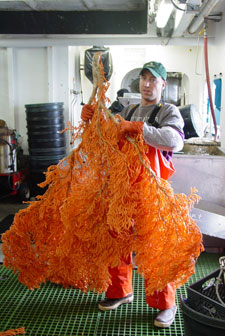NOAA Rejects Endangered Species Petition for Alaska Corals

Tuesday, February 12 2013
A petition for the federal government to list several dozen species of Alaska cold water corals as endangered has stalled after an initial review.
Biologist Kiersten Lippmann submitted the petition on behalf of the Center for Biological Diversity. She says the corals need better protections because they are often the only structures on the ocean floor.
“They’re kind of like trees would be in a terrestrial environment, in that they provide that sheltered habit and a place to rest and feed from for a whole host of species.”
There are at least 130 coral species in the Bering Sea and Aleutian Islands, but scientists don’t know much about their abundance and distribution. Of the 43 species listed in Lippman's petition, quite a few were identified only in the last few years.
“So this is kind of cutting edge research on the coral," she says.
And Lippman thinks there are probably more out there to discover -- so long as they don’t disappear first. She says over the next century, the corals will be threatened by ocean warming and acidification. But she sees a more immediate threat from fishing.
“The problem with fisheries impacts is that they’re occurring at a much faster rate, so these species could just be wiped out before they’ve even had a chance to be documented.”
As it stands, fishermen remove between 50 and 100 tons of coral and sponges from the Bering Sea and Aleutian Islands every year as bycatch. That’s approximately the same mass as two or three humpback whales. And large parts of the region have been closed to bottom trawling since 2005, when the North Pacific Fishery Management Council adopted coral habitat protection measures. But Lippman says because pelagic, or mid-water, trawl nets still make contact with the sea floor about half the time, those measures aren’t good enough.
“Another problem with the areas that the Council protected is that many of the miles -- the square nautical miles that they protected -- they just don’t have any corals in them. It’s just mud flats. So those areas don’t really mean anything.”
The National Oceanic and Atmospheric Administration disagrees, which is part of the reason the agency declined to pursue Lippman’s petition past an initial 90-day review. Spokesperson Julie Speegle says there’s simply no data to show fishing or ocean acidification are hurting Alaska’s cold water corals, and in fact that NOAA’s science actually contradicts the latter.
“All the species mentioned in the petition have a type of external tissue that protects them from acidic water, so they may not be as susceptible to the effects of ocean acidification as some of the other organisms.”
But Speegle acknowledges that there are still a lot of other unknowns about Alaska’s corals, and says the agency is intensifying its research efforts.
“Beginning last year, 2012, we did implement a 3-year field research program in Alaska as part of NOAA’s deep sea research and technology program. So we’re hoping that will help answer some questions with regards to corals in Alaska.”
In the meantime, the Center for Biological Diversity will likely continue its pressure campaign. Lippman says she thinks NOAA’s refusal to do a full, 12-month review of the petition is illegal, and that her organization is weighing its options for moving forward.




Maureen Gilman on Tuesday, March 05 2013:
Julie Speegle: Why not protect as much coral as possible while NOAA gathers more data that shows conclusively that fishing does not impact the coral? The decision to ignore the petition is short-sighted. Ultimately, you'll have no fish to protect either!